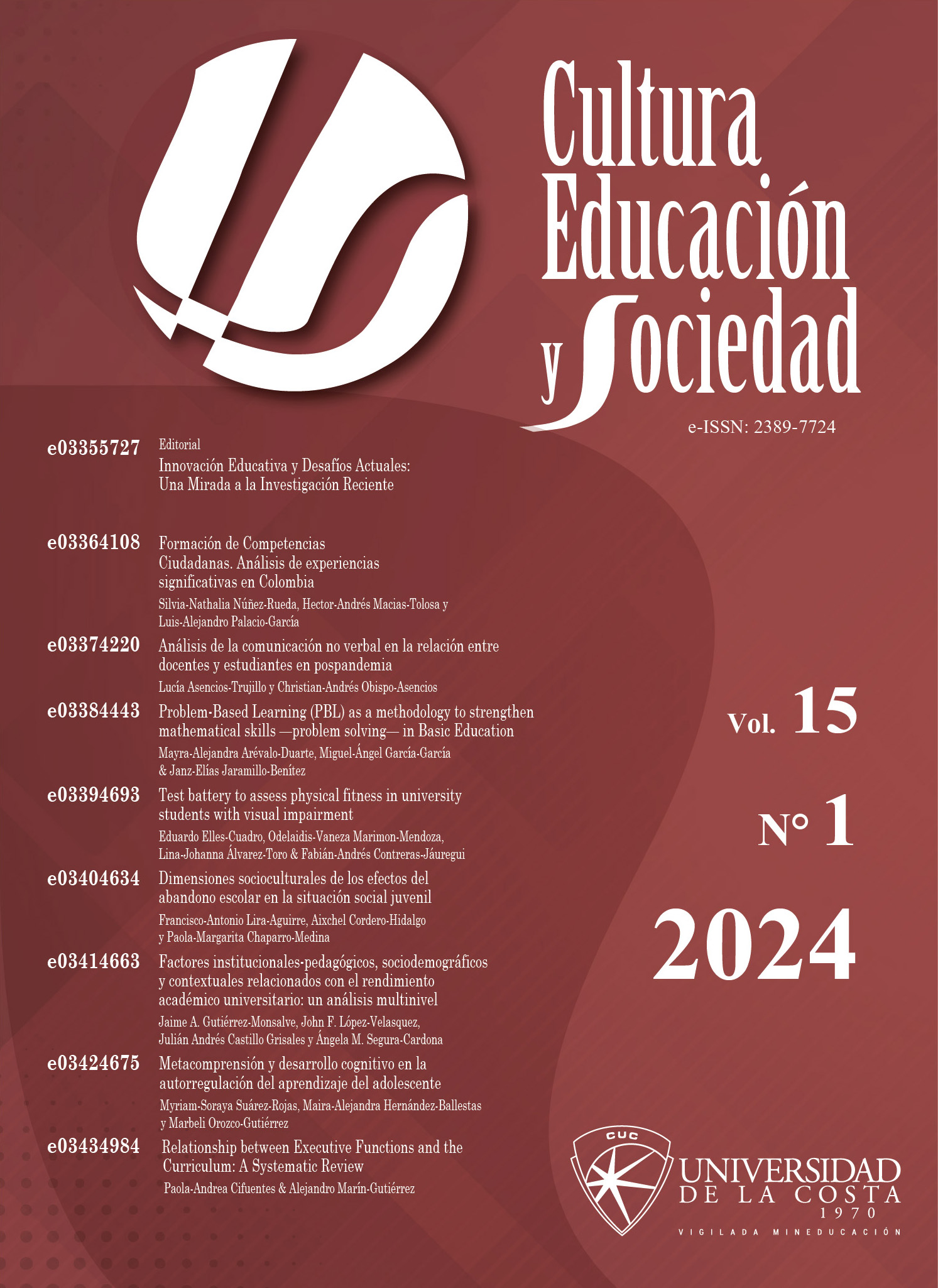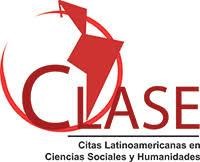Analysis of nonverbal communication in the relationship between teachers and students in post-pandemic post-pandemic
DOI:
https://doi.org/10.17981/cultedusoc.15.1.2024.4220Keywords:
Nonverbal communication; assertiveness; interpersonal skills; behavioral stylesAbstract
Introduction: Immediate is the issuance of appropriate non-verbal behaviors of gestures and postures, perceived as assertive non-verbal behaviors, which allows emotional circuits to be modulated based on a value system, influencing the disposition, motivation, interest and cognition of students for learning. Objective: To describe the level of immediacy of teachers in the interrelation with students, during pedagogical practice in post-pandemic times. Methodology: Study with quantitative approach, type of descriptive research and with a simple cross-sectional analytical descriptive design. The population was 312 Peruvian university professors, selecting 150 subjects by non-probabilistic sampling. The NIS-immediacy-questionnaire adapted by Richmond, McCroskey and Johnson was applied in 2013, with good content validity and high reliability (.808). Results: 22% with a high level of immediacy, manage their emotions, behaving based on their cognitive capacity, assuming open and receptive attitudes, demonstrating prudence and tolerance; 78% have low levels of immediacy, reacting on impulse, proving to be intransigent and inflexible. Conclusions: The impactful social skills in teacher-student interaction is assertive behavior, emitted through non-verbal components, evidencing a style of behavior, with a certain level of immediacy. Teachers with high levels of immediacy tend to have self-control, emit appropriate non-verbal behaviors, creating favorable environments in pedagogical interaction. Those who present low levels reflect emotional discomfort with a greater risk of displaying inappropriate behaviors, evidencing agreeive and/or passive nonverbal behaviors.
Downloads
References
Aydin, M., Miller, J., Xiaojun, Y., Mentes, T., Leblebici, D., Yildiz, M. & Erkul, E. (2013). Nonverbal Immediacy and Perception of Learning: A Cross-Cultural Survey in Turkey, USA and China. Hacettepe Üniversitesi Eğitim Fakültesi Dergisi, 44, 27–42. https://dergipark.org.tr/tr/pub/hunefd/issue/7792/101939
Bainbridge, A. (2021). Un modelo de motivación: la inmediatez no verbal en el aula de clase. Escribania, 19(1), 11–18. https://doi.org/10.30554/escribania.v19i1.4319
Birdwhistell, R. (1968). Kinesics: Inter- and intra-channel communication research. Social Science Information, 7(6), 9–26. https://doi.org/10.1177/053901846800700603
Blas, A. (2021). Estilos de comunicación que practican los estudiantes del nivel secundario en la institución educativa de Lima Metropolitana [Tesis profesional. Universidad Nacional Mayor de San Marcos]. Cybertesis. https://hdl.handle.net/20.500.12672/17147
Cantillo, M. (2015). Uso del lenguaje no verbal en la comunicacion docente. [Tesis doctoral, Universidad de Alicante]. RUA. http://hdl.handle.net/10045/46195
Cortez, A. (2018). Indicadores de comunicacion asertiva del docente y la generacion del clima escolar [Tesis maestría, Universidad Andina Simon Bolivar]. UASB-DIGITAL. http://hdl.handle.net/10644/6221
Davis, F. (2007). La comunicación no verbal. Alianza Editorial.
De Sotto, E. y Mambié, M. (2023, 2-4 de marzo). Comunicación no Verbal. En AEPP (Org.), Taller: Habilidades de comunicación no verbal [Ponencia]. 19 Congreso online de actualización en Pediatría, Madrid, España. https://www.aepap.org/sites/default/files/pag_433_436_comunicacion_no_verbal.pdf
Espinoza, Y., Mesa, D., Díaz, Y. y Caraballo, L. (2020). Estudio del impacto psicologicode la COVID-19 en estudiantes de las Ciencias Médicas, Los Palacios. Revista cubana de la salud pública, 46(Supl. Esp.), 1–17. https://revsaludpublica.sld.cu/index.php/spu/article/view/2659
Etebom, L. & Timothy, E. A. (2022). Workplace Peace Construction Through Verbal and Non-Verbal Communication in the University of Calabar [unpublished]. University of Calabar. https://dx.doi.org/10.2139/ssrn.4000065
Gallegos, F., Iturralde, R., León, M. y Rodríguez, V. (2020). Cuadernos de investigación 4. Comunicación no verbal y la percepción en el campo de los negocios. UVRL.
Garzón, M. (2014). Importancia de la actitud del docente en el proceso de aprendizaje [TrabajoEspecialización, Universidad Pedagógica nacional]. Repositorio Institucional UPN. http://hdl.handle.net/20.500.12209/571
García-Morato, C. y Fernández-Baíllo. (2019). Respuestas comportamentales y fisiológicas. [Tesis Doctoral, Universidad Autonoma de Barcelona]. DDD UAB. https://hdl.handle.net/10803/669554
Gou, H., Gao, W. & Shen, Y. (2022). L2 Enjoyment of Inglish as a Foreign Language Studets: Does Teacher Verbal and Non-verbal Immediacy Matter? Frontiers in Psychology, 13, 1–8. https://doi.org/10.3389/fpsyg.2022.897698
Hernández, R., Fernández, C. y Baptista, P. (2014). Metodología de la investigación [6 ed.]. McGraw-Hill.
Hofstadt, C. (2015). Libro de las habilidades comunicativas. DiazdeSantos.
Huarcaya-Victoria, J. (2020). Consideraciones sobre la salud mental en la Pandemia de COVID-19. Revista Peruana de medicina experimental y salud pública, 37(2), 327–334. https://doi.org/10.17843/rpmesp.2020.372.5419
Hurtado-Martín, M., López-Torres, L., Santín , D., Sicilia, G. y Simancas, R. (2023). El impacto del COOVID-19 en el aprendizaje durante el confinamiento. Educacion XX1, 26(1), 185–205. https://doi.org/10.5944/educxx1.33047
Karam, T. y Cañizález, A. (2010). Veinte formas de nombrar a los medios masivos. UniAndes. http://www.saber.ula.ve/handle/123456789/31682
López, E. y Sanz Ponce, R. (2021). Construcción y Validación del cuestionario de autopercepción sobre las competencias docentes del profesorado. Revista Educatio Siglo XXI, 39(3), 157–186. https://doi.org/10.6018/educatio.427461
Mehrabian, A. (1968). Communication Without Words [2 ed.]. Routledge. https://doi.org/10.4324/9781315080918-15
McCroskey, J. C. & Richmond, V. P. (1974, April 17-20). Toward the Measurement of perceived homophily in interpersonal comunication [Paper]. Annual Meeting of International Comunication Association, New Orleans, USA. https://files.eric.ed.gov/fulltext/ED094433.pdf
Nie, N., Hadlai C. & Bent, D. (2014). SPSS (v. 23). [Statistical Package for the Social Sciences]. IBM. https://www.ibm.com/mx-es
Puertas-Molero, P., Zurita-Ortega, F., González-Valero, G. & Ortega-Martín , L. (2022). Design and Validation of the Non- Verbal Immediacy Scale (NVIS) for the Evaluation of Non-Verbal Language in University Professors. International Journal of Environmental Research and Public Health, 19(1159), 1–12. https://doi.org/10.3390/ijerph19031159
Qin, J. (2022). A Theoretical Review on the Role of English as a Foreign Language Teachers’ Self-Disclosure in Shaping Classroom Climate and Immediacy. Frontiers in Psychology, 13, 1–8. https://doi.org/10.3389/psyg.2022.945046
Richmond, V., McCroskey, J. & Johnson, A. (2003). Development of the Nonverbal Immediacy Scale (NIS). Communication Quarterly, 51(4), 504–517. http://www.jamescmccroskey.com/publications/203.pdf
Rivas, A. (2015). América Latina después de PISA. Lecciones aprendidas en siete países (2000-2015). Fundación CIPPEC.
Sánchez, H. y Reyes, C. (2015). Metodología y diseños de la investigación científica. Bussines Support Aneth.
San Hipólito, M. (2014). Las habilidades sociales en educacion infantil. [Trabajo grado, Universidad de Valladolid]. UVadoc. http://uvadoc.uva.es/handle/10324/5886
Tower, P. (1979). Fundamentals of interpersonal behavior: A socialpsychological perspective. En A.S. Bellack y M. Hersen (eds.), Research and practice in social skills training [pp. 3–40]. Plenum Press. https://doi.org/10.1007/978-1-4899-2192-5_1
Valencia, M. (2019). Psicólogo. Revisión sistémica sobre influencia de comunicación no verbal en los procesos de enseñanza-aprendizaje [Trabajo de pregrado, Universidad de Antioquía]. Repositorio Institucional Universidad de Antioquia. https://bibliotecadigital.udea.edu.co/handle/10495/15681
Wolpe, J. (1958). Psicoterapia Por Inhibición Recíproca. Desclée De Brouwer.
Zhang, D., Lin, H. & Perrett, D. (2022). How head posture affects perceived cooperativeness: A cross-cultural perspective. Acta Psychologica, 227, 1–7. https://doi.org/10.1016/j.actpsy.2022.103602
Published
How to Cite
Issue
Section
License
Copyright (c) 2023 CULTURA EDUCACIÓN Y SOCIEDAD

This work is licensed under a Creative Commons Attribution-NonCommercial-NoDerivatives 4.0 International License.
![]()
Creative Commons 2020 CULTURA EDUCACIÓN Y SOCIEDAD
This article is under international license Creative Commons Reconocimiento-NoComercial-SinObrasDerivadas 4.0.
The published articles are the sole responsibility of their authors and do not necessarily reflect the opinions of the editorial committee.
CULTURA EDUCACIÓN Y SOCIEDAD respects the moral rights of its authors, who assign to the editorial committee the patrimonial rights of the published material. In turn, the authors inform that this work is unpublished and has not been previously published.
All articles are under a:
Licencia Creative Commons Atribución-NoComercial-SinDerivadas 4.0 Internacional.
![]()


 English
English
 Español (España)
Español (España)




_12.53_.27_p_. m_._3.png)





_12.57_.35_p_. m_._3.png)
_12.50_.37_p_. m_._3.png)



